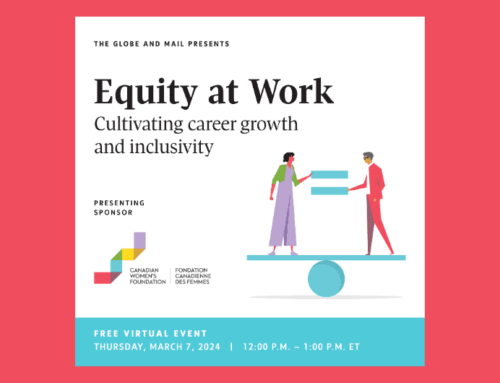Brandie Weikle is the host of The New Family Podcast. This post was originally published here.
I’m all for flowers, books and mani-pedi gift certificates. But the truth is moms really need forward-thinking policy change, the kind of game-changing, culture-shifting, brave-ass investments in everyone’s future that make raising up the next generation of taxpayers and gerontologists a lot more sustainable. (Because, yes, we can predict the critics who’ll say “Your kid, your problem!” But who will pay for the critics’ CPP and health care if not the kids we’re putting through day care today?)
The policies on this wish list would help all families, whether or not there’s a mom in the mix at all. But since Mother’s Day is just around the corner, let’s imagine — for sake of argument — that you could put a bow on these big-ticket items:
Access to quality, affordable child care
This country has been debating the merits of a universal child-care program for decades. Sadly, this usually runs up against anti-big-government rhetoric that suggests implementing child-care programs would be tantamount to ponying up for a second health care system.
The fact is child care is a straight-up excellent investment. A TD Bank survey found that every buck put into early childhood education returns between $1.50 and $3 to the economy. In a speech at Queen’s University last year, Stephen Poloz himself — governor of the Bank of Canada — said Quebec’s subsidized daycare program has increased the “prime-age female workforce” from 74 per cent to 87 per cent.
Alas, in most of the rest of the country, the shortage of quality, affordable child care is keeping too many moms out of the workforce. Statistics Canada’s latest Survey on Early Learning and Child Care Arrangements found that a third of parents with kids under the age of six had experienced difficulty finding childcare. One in 10 parents have had to change their work schedules to fit with sub-optimal child care arrangements, it found.
B.C., Alberta and Newfoundland and Labrador made some meaningful progress on child care in 2018. In some part of the country, however, we’re moving backward on this front. In Ontario, for example, cuts and changes to childcare funding under Doug Ford’s policies are expected to put more than 6,000 subsidized daycare spaces at risk in the City of Toronto alone.
Flexible work cultures
As long as the workday and the school day remain out of sync by several hours — in absence of easy access to after-school care for our kids — parents will continue to experience grave difficulty meeting the commitments of both work and child-rearing.
Unfortunately, this conflict has a disproportionate effect on women’s participation in the workforce. According to Statistics Canada, 15 per cent of women who left their jobs in 2018 and are now out of the labour force did so for personal or family reasons. That’s compared to just three per cent of men who left for those same reasons.
Until workplaces divorce themselves from outdated notions like strict 9-5 hours with the emphasis on facetime over outcome, moms will bear the brunt of the sweaty, stressed out subway rides or white-knuckle drives through traffic to get to daycare. Either that or they’ll take their 57 per cent of all new university degrees out of our low-unemployment economy and stay home, if their circumstances allow. Alternatively, they’ll downgrade their career aspirations to roles that aren’t as demanding or opt for some form of self-employment.
Mental health services for their children
We know that our children are more likely than ever to suffer from anxiety and depression. While things are beginning to improve somewhat, difficulty accessing mental health services for kids is contributing to the gender wage gap for moms.
A 2019 report from Children’s Mental Health Ontario found that one in four parents have missed work to help a child suffering from anxiety and one third are currently seeking mental health services for a child.
For one of my recent Toronto Star parenting columns, I spoke to Lydia Sai-Chew, CEO of Skylark, a Toronto-based charitable organization that provides mental health services free of charge to children and youth and their families. She said that it’s often moms who use up all their vacation and sick time to get their children to all the necessary appointments, nevermind managing all the advocacy and follow-up required to access help in the first place.
Classroom support for kids with special needs
Speaking of meeting our kids’ needs, we’d love reasonable class sizes where educators have a fighting chance of differentiating their teaching to our kids’ various learning styles, and where there’s special ed support for kids who need it.
What we don’t want, for example, is to be stuck with $80,000-per-year bills for autism services once covered by provincial programs.
Equal pay
Next up, we’d love to make the same money as our male counterparts for the same work. Alas, Canada still has the 8th highest gender wage gap out of 46 countries examined in an OECD study based on 2016 data.
According to StatsCan, we’re earning around 87 cents to every dollar earned by men. That’s like spending the first 47 days of the year without pay.
Payroll services provider ADP Canada reported that, based on self-reported data, Canadian women earn on average $49,721 per year compared to $66,504 for men.
Let’s leave aside the pay gap for a moment. If wages in general — regardless of gender — would just keep up with the cost of living, that would be swell. Instead, for example, in inflation-adjusted dollars, it costs many more times what we earn in annual salary to buy a house than it did for our parents and grandparents. Wasn’t it cute when people paid no more than three times their annual household income for a house? Today that figure can look like eight or even 11 times annual salary to buy a home in the hotter real estate markets where, alas, most of the jobs are still found.
And, holy cow, do parents need the money, especially when you consider that the traditional finish line for parenting has moved so far out. As I learned from Ann Douglas’s book Happy Parents, Happy Kids, which includes some great insights on the effect that financial anxiety is having on parents, two-thirds of parents in the U.S. expect to be providing some sort of financial support to their children up to five years after they graduate from university, a trend that, if not exactly the same, is surely similar on this side of the border.
More vacation time
Now, not to get greedy, but while we’re fixing our workplace problems, dare I say that we’d like the bare minimum legal vacation allowance per year to be raised from two to four weeks? Compared to more progressive nations all over the world, Canada lags behind in vacation allowance, and it shows on all of our wrinkled foreheads.
Moms especially would love not to have to burn through half or more of their annual vacation time with sick-kid emergencies and PA days. Give us four weeks to start, with a trajectory for earning five, six weeks and beyond as we accumulate years of service. Then we’ll have a fighting chance of not just covering the stomach bugs and bus cancellations, but of going on an actual week or two of vacation during our kids’ nine weeks off each summer.
I’d trade that for all the mani-pedis in the world.
Learn More:
- Mother’s Day Moxie: 20 Ways Your Moms Empowered You
- 7 Confidence-Boosting Books for Girls
- No, Moms, the gender pay gap is not on us
Take Action:
Sign up for our e-newsletter to have our latest stories and resources sent to your inbox.
Follow us on Facebook and Twitter to join a national conversation about empowering girls.







